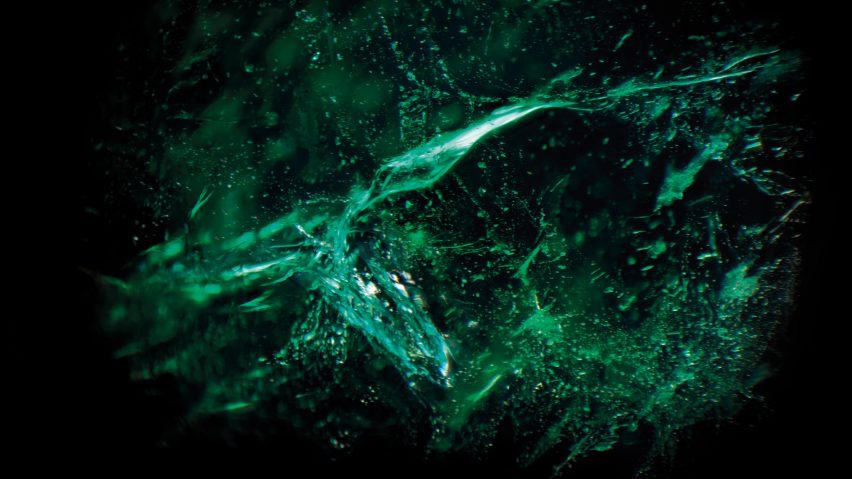Photographer Dan Tobin Smith used footage of more than 100 gemstones, blown up to 60 times their size, to create an immersive installation in the basement of Collins Music Hall for London Design Festival.
The focal point of Void was a square of screens, set on a raised platform in the centre of the room, with each screen giving visitors a glimpse into the varied inner life of different crystals.
Projected on to the screens were extremely close-up images of the kaleidoscopic worlds hidden within each stone, recreated on a vast scale.
"I discovered that filming [the stones] made them really come alive," Tobin Smith told Dezeen. "And in the end I thought it would be a shame to just leave them as films, so the idea of an installation started taking shape."
London design studio The Experience Machine was tasked with displaying the films in the subterranean concrete space, which was achieved through the 360-degree screen set-up.
The light projections captured on the central cube of screens were a visual representation of gemstone inclusions – other elements that become encased within the crystal during its formation.
For two special performances during the festival, Void's otherworldly nature was underscored by an eery chorus of layered female voices courtesy of the electronic drone choir NYX.
"I felt that the human voice would work well with the inclusions because they are these tiny, imperfect but beautiful things," said Tobin Smith. "I like the idea of the voices connecting us to the inclusions, saying we are part of the same physical system."
Over the course of three years, Tobin Smith either bought or borrowed the more than 100 specimens that are featured in the project, and filmed each of them.
These include semi-precious gemstones created through rare geological processes, alongside rubies from Mozambique and Zambian emeralds that date back millions of years.
Many of the stones were sourced through Gemfields, a supplier of responsibly sourced gemstones and supporter of the project.
Tobin Smith said that the project constitutes the largest collection of filmed footage documenting the inner structure of gemstones. And to create it, he had to develop entirely new production methods.
"We mounted a Leica Gemological microscope to a digital cinema camera called an Arri Mini," he explained.
"This is the same camera that is used on feature films such as Blade Runner 2049 and has a wonderful filmic sensor and colour space."
The movement within the projections, which creates the impression of free-floating galaxies, was achieved through a custom motion-control rig.
"We needed the stones to turn very slowly and accurately," said Tobin Smith.
"This was quite hard and took months and months to perfect, because when you're in at times 60 magnification, any kind of vibration becomes extremely visible – something which can't be corrected in post-production."
With Void, he hopes to make us question the boundaries of where nature ends and design begins: "Unearthing these inclusions is like opening up a massive catalogue of textures, patterns, colours and forms, things you haven't seen before and you couldn't design."
"Nature has created these things through insane timescales and crazy randomness," said Tobin Smith.
"They often feel designed because they are so strange and novel and I think seeing that nature is responsible for these things through the photographic medium is enlightening. It shows how huge and incompressible nature is," he continued.
Other installations at the London Design Festival, which ran until 22 September, included Kengo Kuma's Bamboo Ring and a colourful "urban living room" by designer Camille Walala.
Photography is by Dan Tobin Smith.

